90% of event organizers believe that by 2025*, all large-scale events will have shifted to virtual or hybrid events.
This being the case, not being equipped with the right tech stack can cost you dearly. And one of the key investments you need to make to level up your event marketing game, is a solid, reliable virtual event platform.
Over 4000 enterprises around the world use Airmeet to power their virtual events of all scales. We are also one of the few platforms out there who provides round-the-clock assistance, supports several high-value integrations and empower you with powerful analytics & reporting, among other functionalities.
Here’s a comparison of how Airmeet stacks up against the alternatives, to help you make an informed decision on which virtual events platform to invest in.
1. Airmeet versus Zoom
A popular platform for organizing virtual meetings and webinars, Zoom caters to a large user base with a straightforward use case – online meetings. On the other hand, the infrastructure that Airmeet offers includes more advanced features like breakout sessions, virtual booths, and a variety of networking options that are appropriate for virtual events of different formats, as well as scales.
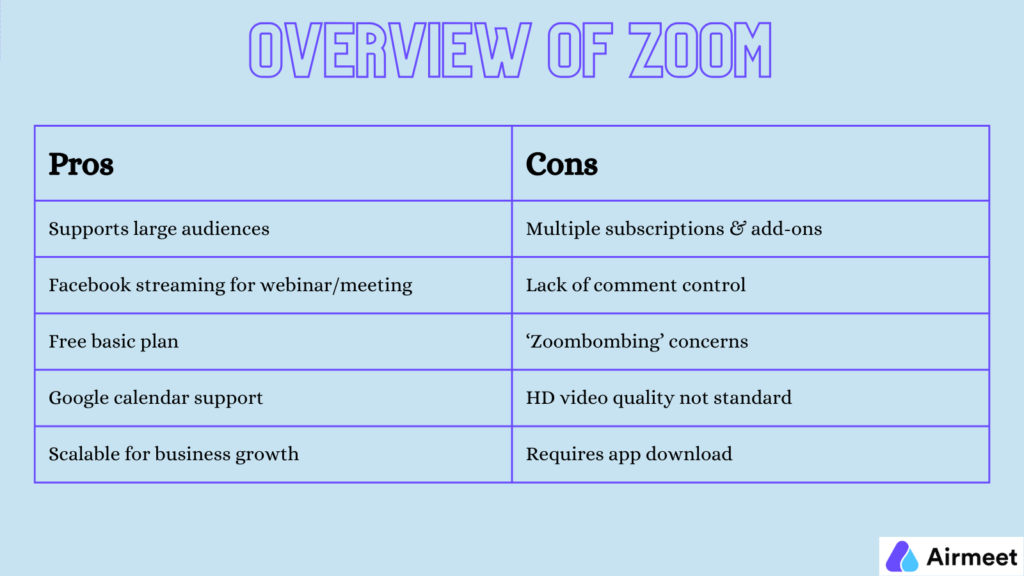
To see the full feature comparison chart and for a more detailed understanding of Airmeet vs. Zoom, click here.
2. Airmeet versus Hopin (now RingCentral)
Hopin(now RingCentral) is widely regarded for being an adaptive virtual event platform. However, Airmeet stands out in comparison because of its distinctive focus on attendee engagement and interaction capabilities. Airmeet provides a digital environment that closely recreates the in-person event experience, with multiple functionalities working together to make this happen.
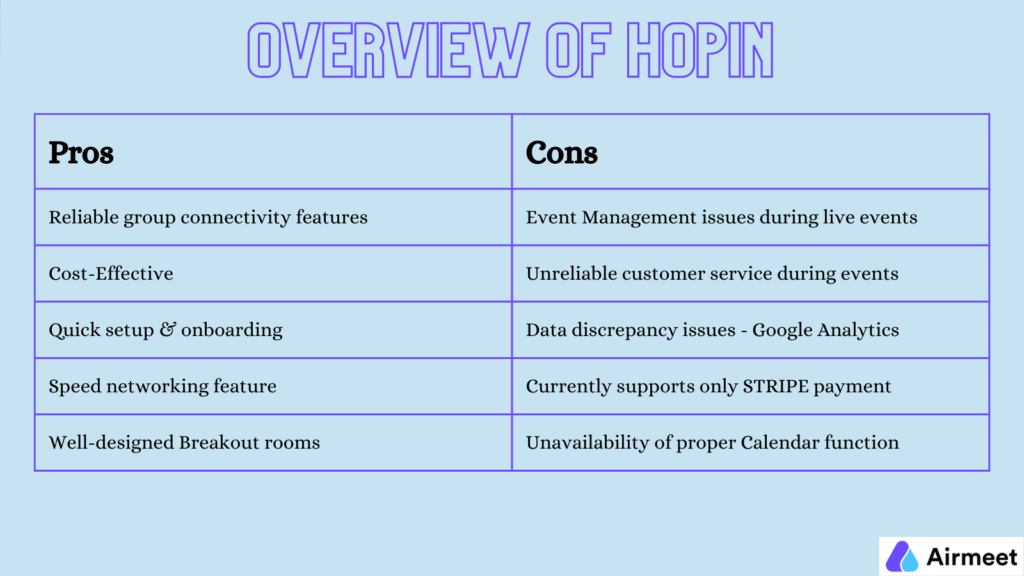
To see the full feature comparison chart and for a more detailed understanding of Airmeet vs. Hopin, click here.
3. Airmeet versus Accel Events
Accel Events provides many features for event planning, ticketing, and sponsorship opportunities, making it a robust choice for event organizers seeking a versatile platform. Airmeet, on the other hand, distinguishes itself with its unique engagement features such as virtual tables and speed networking, which mimic the natural interaction of in-person events more closely. Additionally, Airmeet’s interface is widely acknowledged as being user-friendly, enhancing the overall experience for both organizers and attendees.
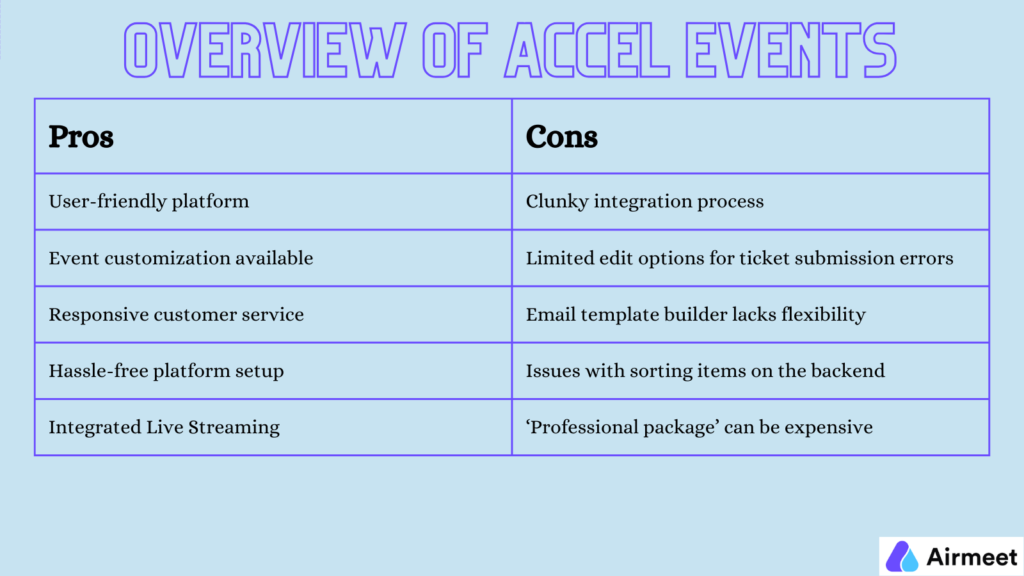
To see the full feature comparison chart and for a more detailed understanding of Airmeet vs. Accel Events, click here.
4. Airmeet versus Zuddl
Airmeet elevates your event with unmatched scalability, engaging interactive features, and a user-friendly platform – all of which ensure a seamless and memorable experience for attendees and organizers. Zuddl on the other hand has its own strengths in customization and in providing immersive experiences, it may not be the ideal choice for organizers looking for more advanced networking features like fluid spaces, breakout rooms, speed networking and more.
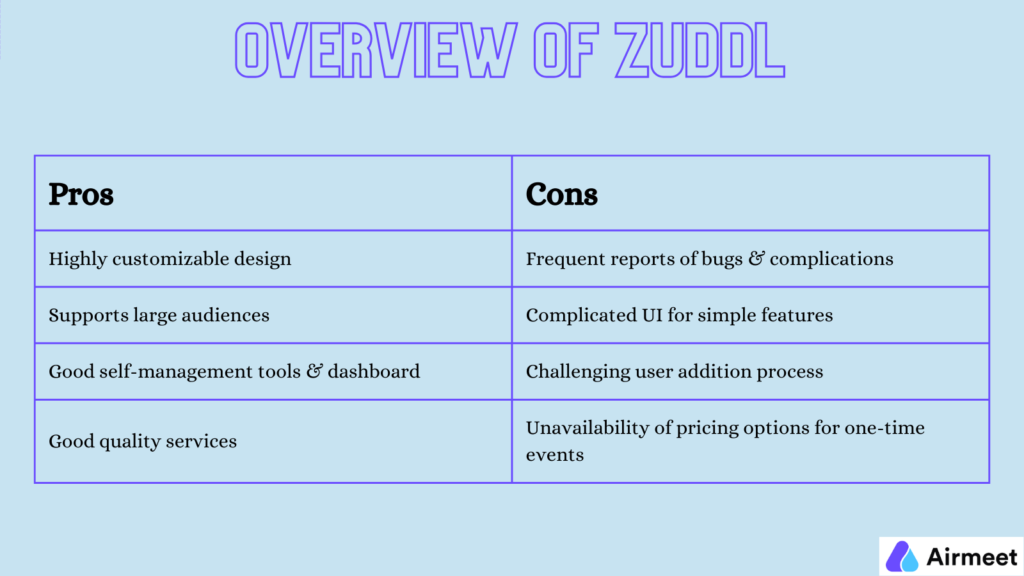
To see the full feature comparison chart and for a more detailed understanding of Airmeet vs. Zuddl, click here.
5. Airmeet versus Remo
While Remo and Airmeet both provide unique opportunities for table-based networking, Airmeet’s dynamic event locations and functionalities greatly enhance the quality of virtual engagements. We give you access to several features which allow you to engage with your attendees, personalize the event, and create lucrative networking opportunities for yourself and your audiences.
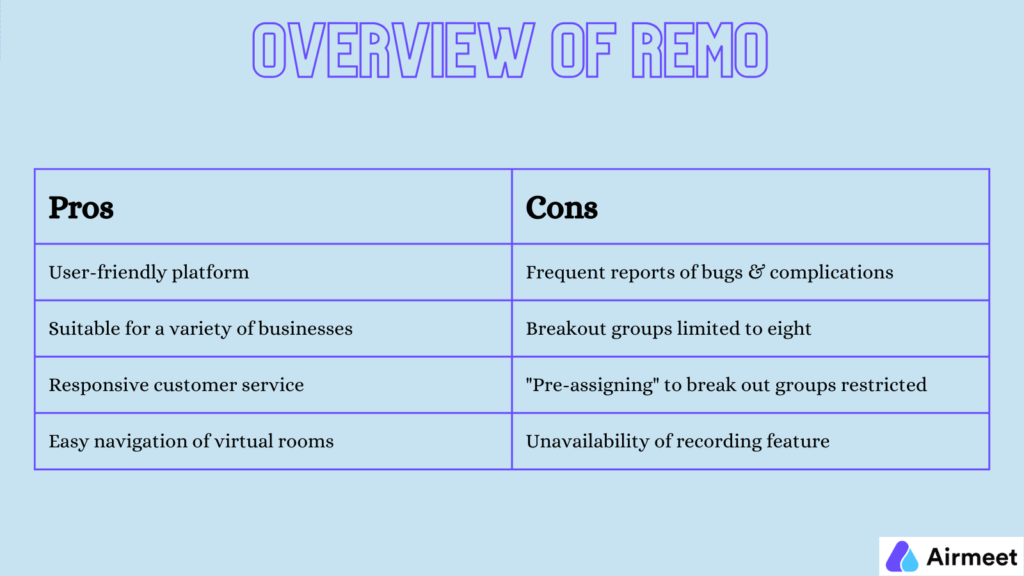
To see the full feature comparison chart and for a more detailed understanding of Airmeet vs. Remo, click here.
6. Airmeet versus vFairs
With virtual booths and 3D surroundings, vFairs is an online event platform that serves to virtualize conventional job fairs and trade exhibits. On the other hand, Airmeet is popular for its easy to use user interface (UI) and features such as deep engagement and interactivity. vFairs offers a more basic experience, while Airmeet has a more extensive range of customizing options.
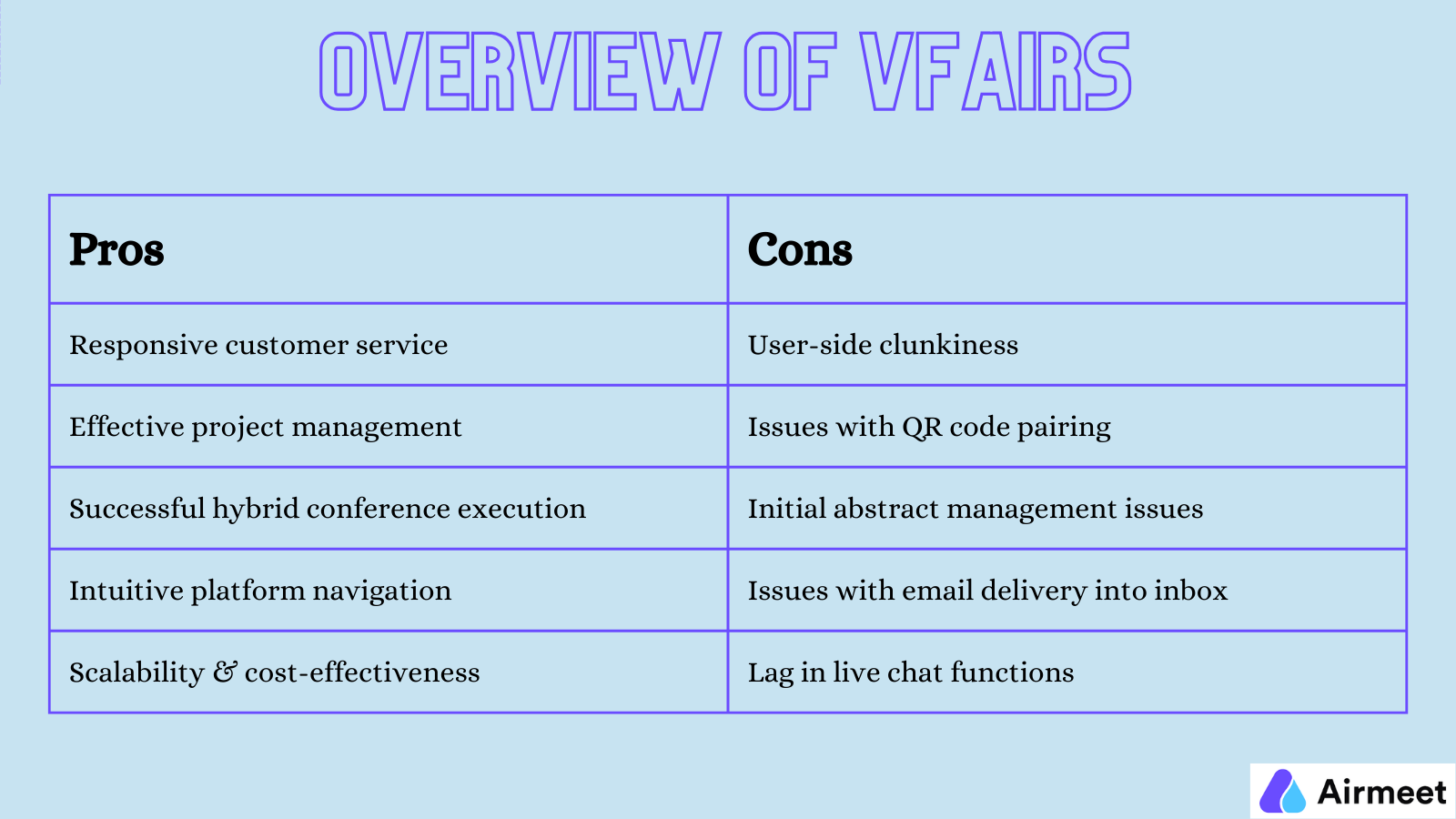
To see the full feature comparison chart and for a more detailed understanding of Airmeet vs. vFairs, click here.
7. Airmeet versus Brella
Airmeet excels in offering a highly interactive and immersive event experience, ideal for both small and large-scale events. In contrast, Brella specializes in targeted networking with its matchmaking algorithm and provides insightful analytics. Airmeet’s comprehensive engagement tools and its ability to deliver virtual events that look and feel very close to an in-person event sets it apart. It elevates the overall event experience and ensures that attendees as well as organizers achieve a substantial return on investment.
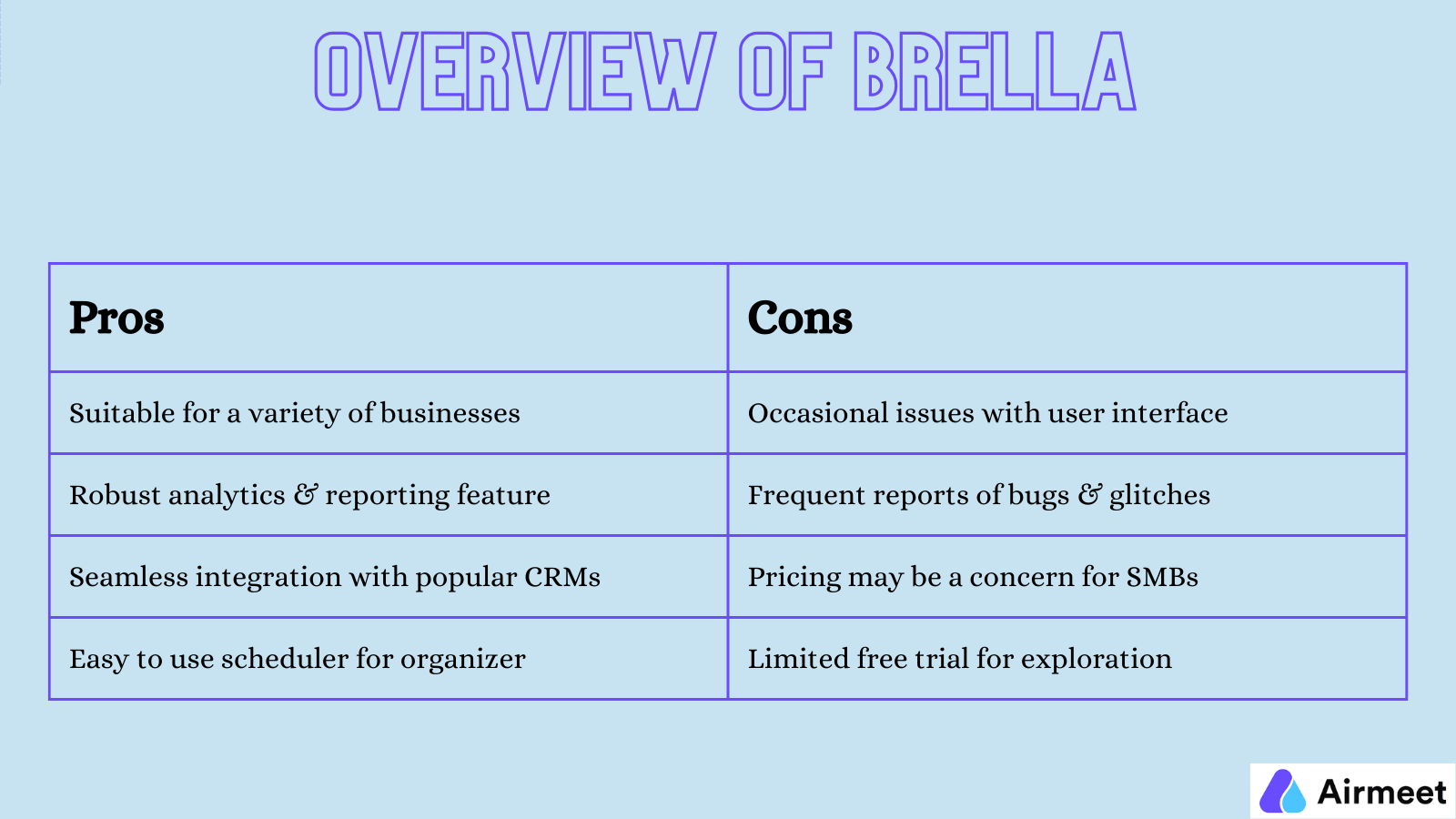
To see the full feature comparison chart and for a more detailed understanding of Airmeet vs. Brella, click here.
8. Airmeet versus Webex Events
Webex Events is known for its reliability and scalability among users. On the other hand, Airmeet is far superior in terms of event engagement functionalities, with features like Lounge- a venue for networking, and Backstage – a platform for speakers, were both introduced by Airmeet, to foster a sense of community and provide high-value event experiences.
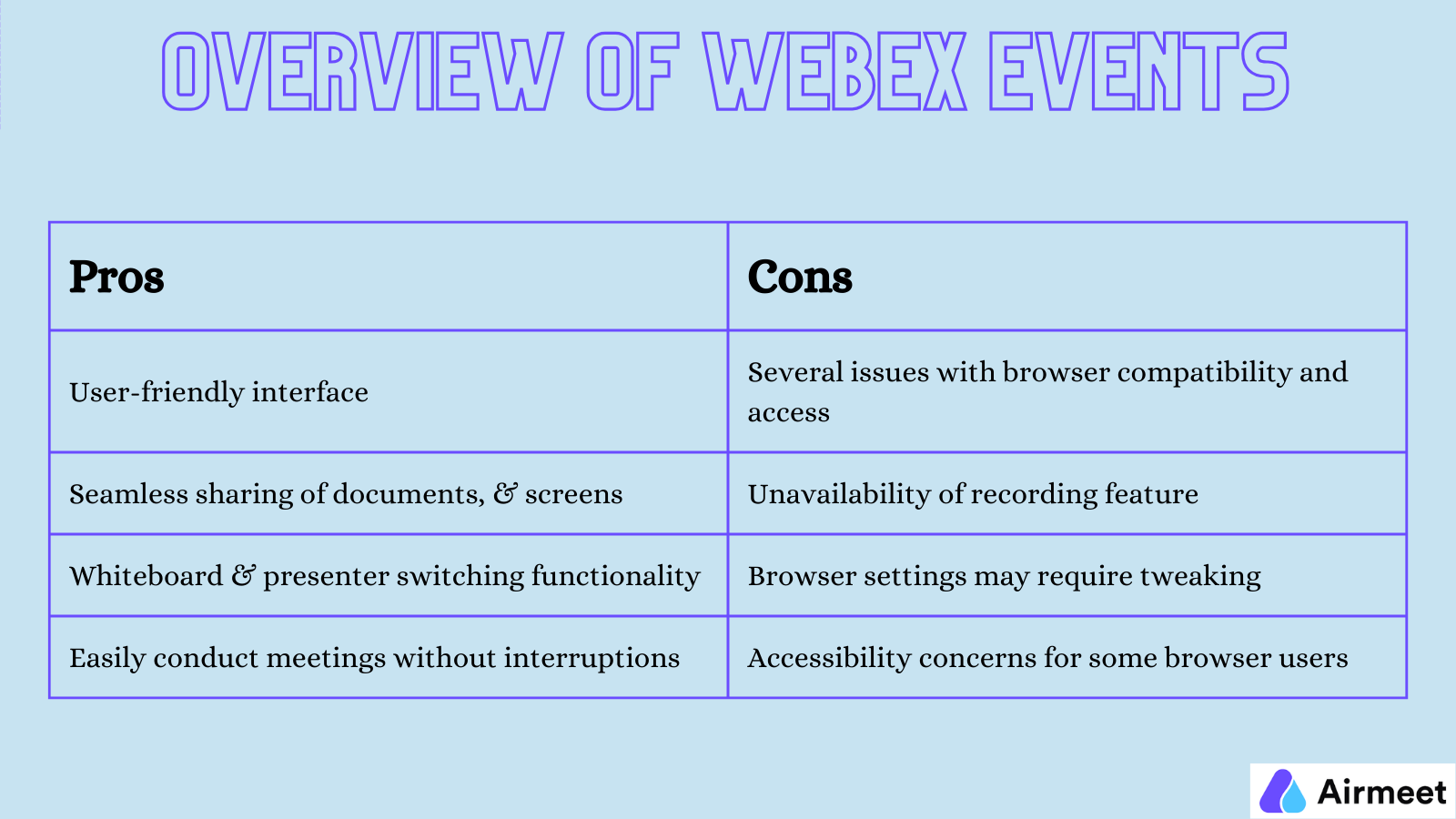
To see the full feature comparison chart and for a more detailed understanding of Airmeet vs. Webex Events, click here.
9. Airmeet versus Google Meet
While it does not have the capabilities that are specific to larger groups, Google Meet continues to be a popular option for simple, straightforward video conferences. On the other hand, Airmeet is designed specifically for event coordinators who want to provide an interactive online platform for their events of all kinds and sizes. Airmeet is known for its scalability, and ease-of-use and is a reliable option for hosting events that are both engaging and impactful.
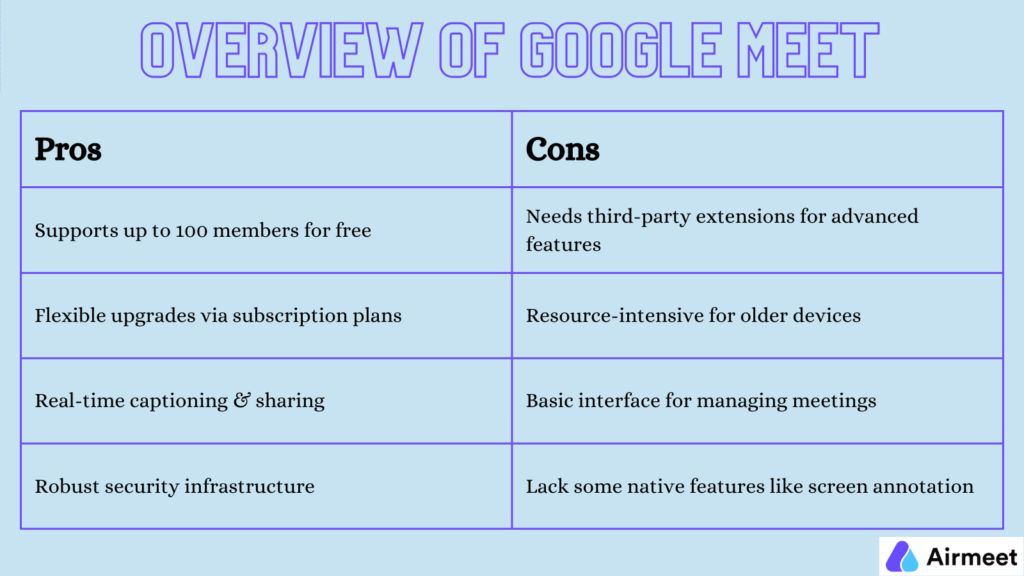
To see the full feature comparison chart and for a more detailed understanding of Airmeet vs. Google Meet, click here.
10. Airmeet versus Cvent
Cvent stands out for its comprehensive and versatile event management tools suitable for both online and offline events. Airmeet, on the other hand, offers a unique edge in virtual engagement, making online events more immersive. This specialization positions Airmeet as a popular choice in the virtual event space, compared to the versatility of Cvent. If you’re looking for a multitude of functionalities and an enriching, engaged online event experience, Airmeet is your solution.
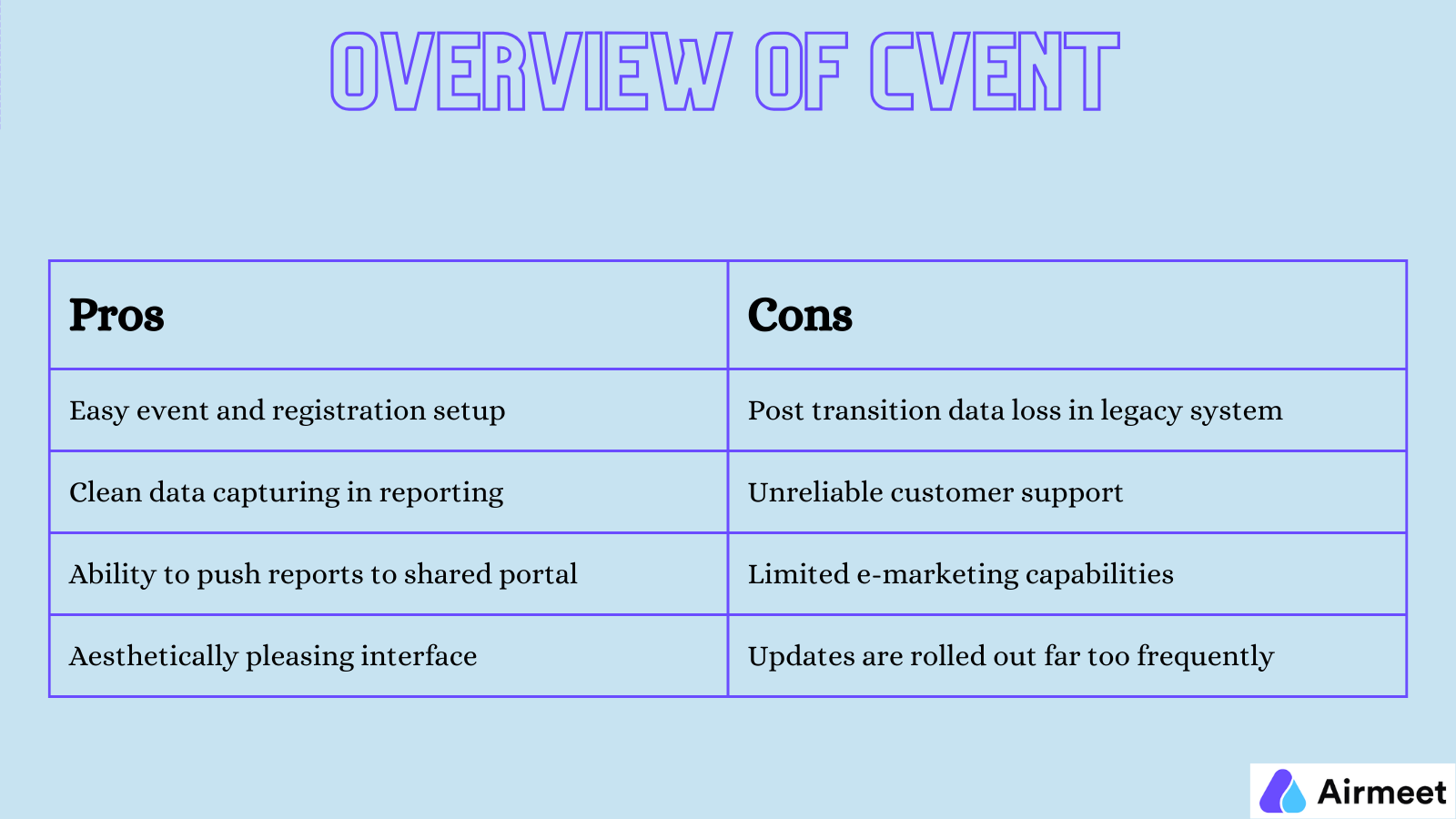
To see the full feature comparison chart and for a more detailed understanding of Airmeet vs. Cvent, click here.
11. Airmeet versus Microsoft Teams
Microsoft Teams, integrated within the Office 365 suite, primarily supports meetings and webinars with features that facilitate straightforward, efficient communication and collaboration. Airmeet, on the contrary, is a widely trusted tool that not only allows brief webinars and team meetings, but also large-scale events like job fairs, virtual conferences and town halls. Airmeet is also more equipped to cater to organizers looking for customization capabilities, audience engagement features, world-class data privacy and security, analytics & reporting functionalities and more.
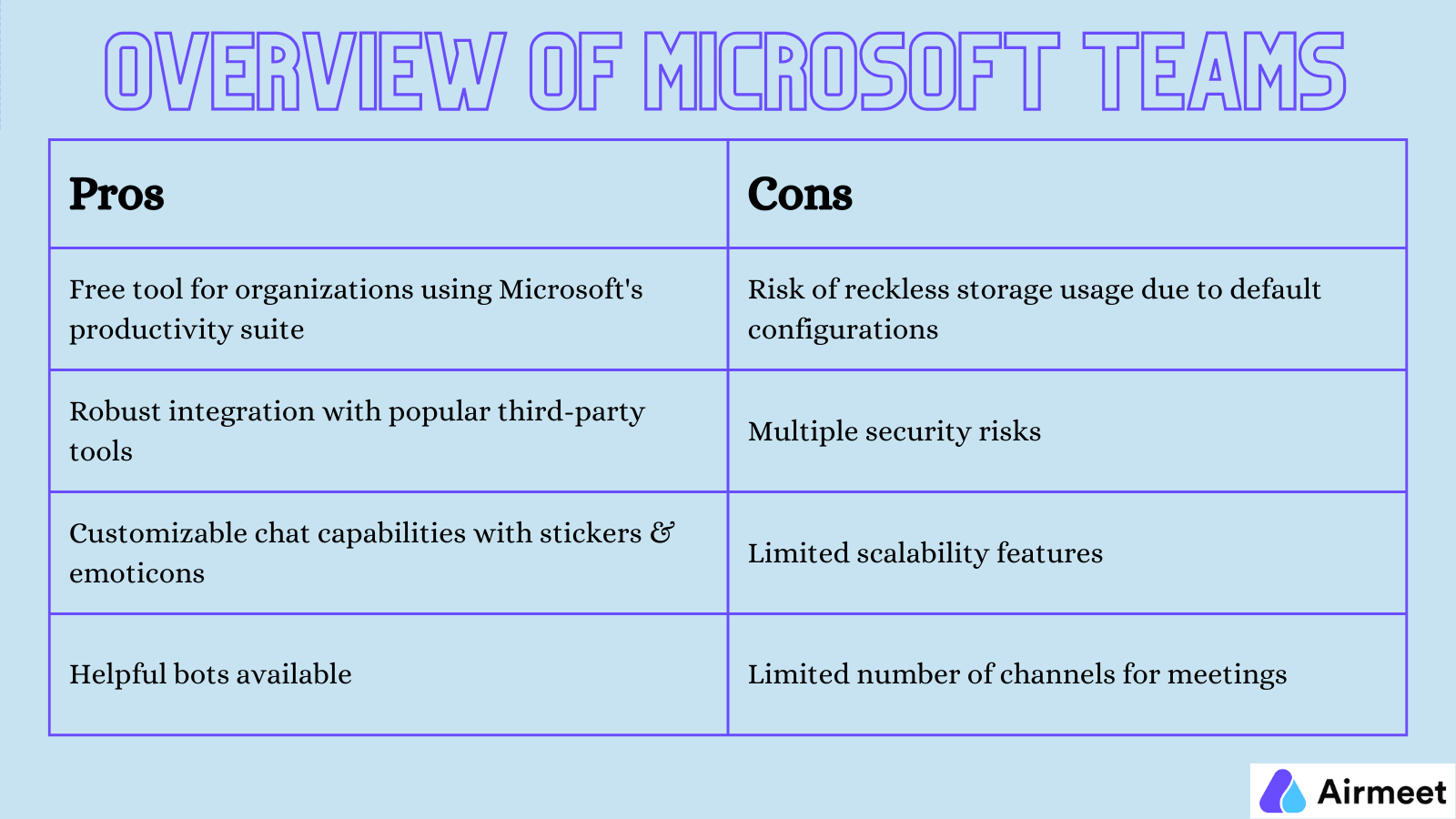
To see the full feature comparison chart and for a more detailed understanding of Airmeet vs. Microsoft Teams, click here.
12. Airmeet versus Bevy
Bevy stands out for its sophisticated community engagement and CRM integration, making it ideal for events focused on long-term community building. While Airmeet is a better choice for delivering a dynamic virtual event experience with features like surveys, virtual booths, and interactive Q&As, tailored for maximizing participant interaction and engagement. Airmeet offers a versatile platform suitable for a wide range of interactive events, from small meetings to large conferences. Compared to Bevy, Airmeet stands out with its user-friendly interface.
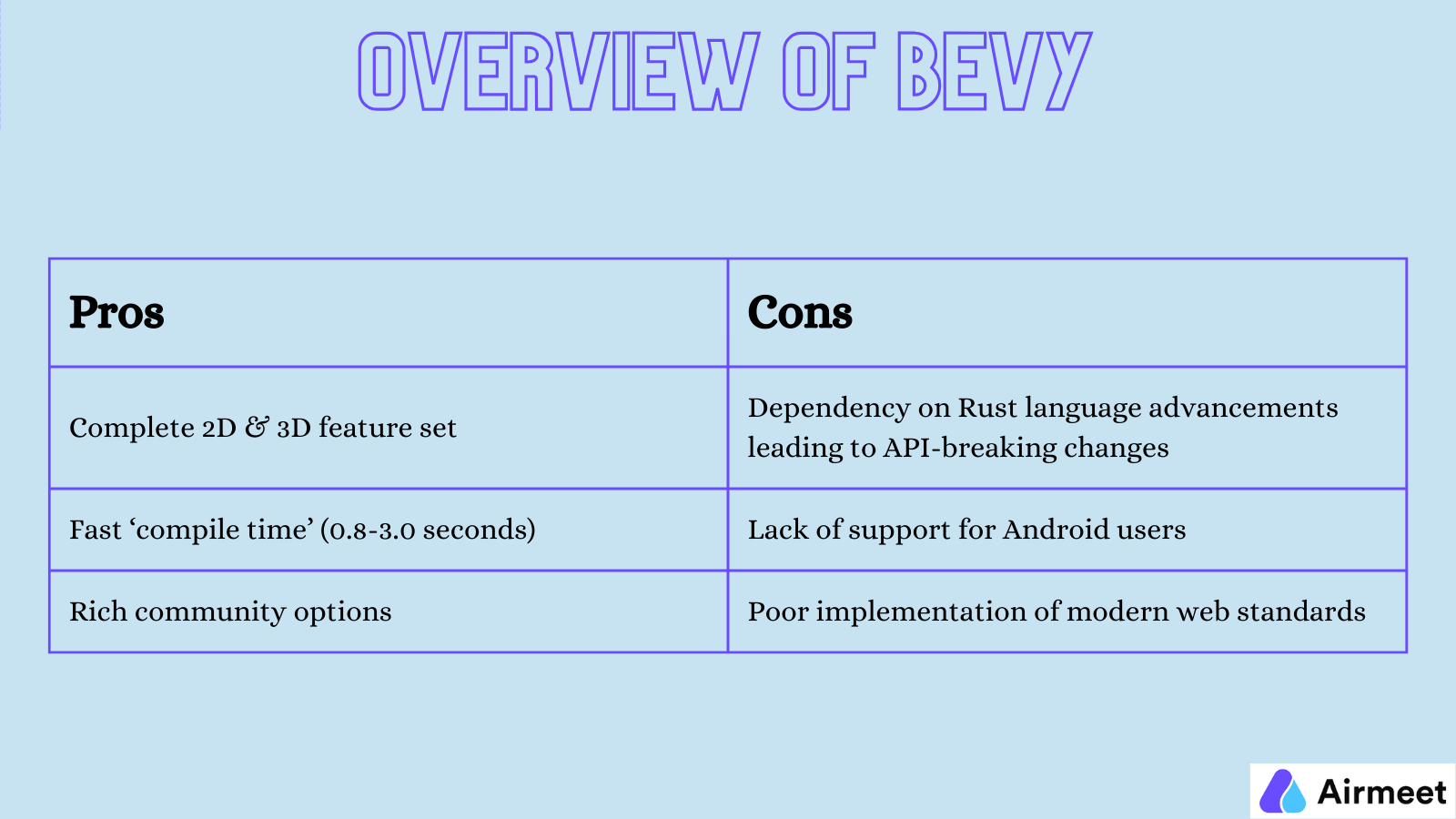
To see the full feature comparison chart and for a more detailed understanding of Airmeet vs. Bevy, click here.
13. Airmeet versus Run The World
Airmeet and Run The World are virtual event platforms that offer interactive features and seamless virtual event hosting capabilities. While Run The World’s interactive elements are somewhat limited, Airmeet stands out for its easily navigable design and greater emphasis on event networking and attendee engagement opportunities.
Moreover, Airmeet provides multilingual support, integration services, and various event types tailored to meet specific customer needs and requirements.
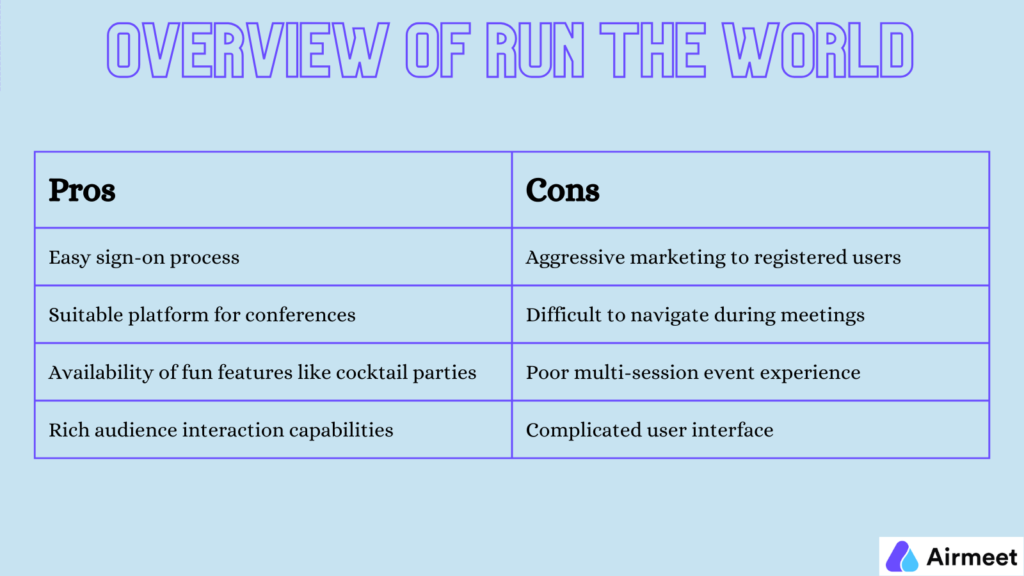
To see the full feature comparison chart and for a more detailed understanding of Airmeet vs. Run the World, click here.
14. Airmeet versus Hubilo
Virtual booths and real-time data are just two of the many features that are made available by Hubilo’s platform. Focusing on delivering impactful attendee interaction and usability, Airmeet differentiates itself from the rest. In addition to having integrated social networking facilities, Airmeet also boasts unique features such as the ability to freely swap between virtual tables.
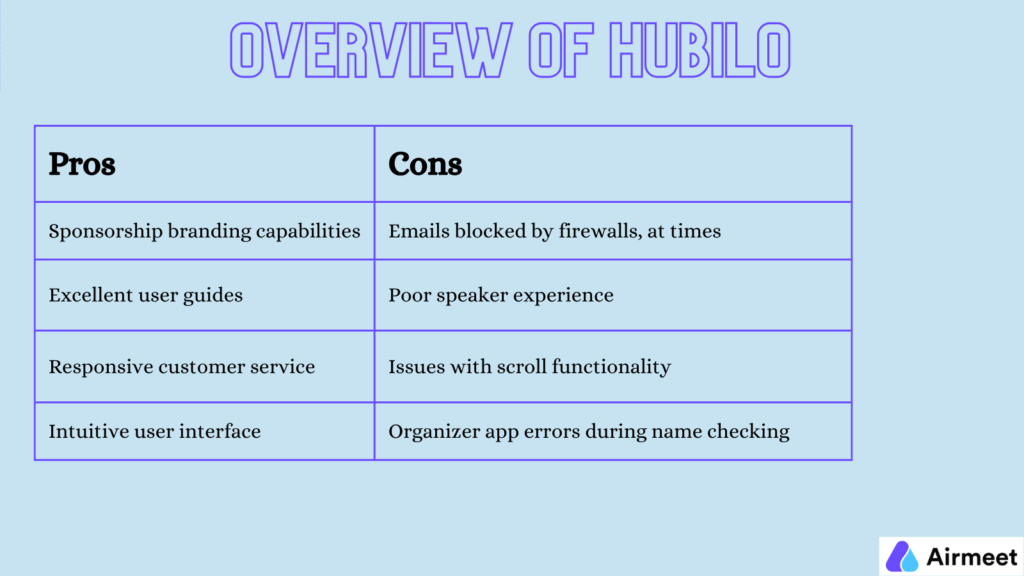
To see the full feature comparison chart and for a more detailed understanding of Airmeet vs. Hubilo, click here.
15. Airmeet versus BigMarker
The marketing tools and webinar hosting capabilities of BigMarker are combined into a single platform. Airmeet, on the other hand, makes virtual meetings and conferences more engaging and impactful, with features like breakout sessions, a virtual backstage for speakers and lots more.
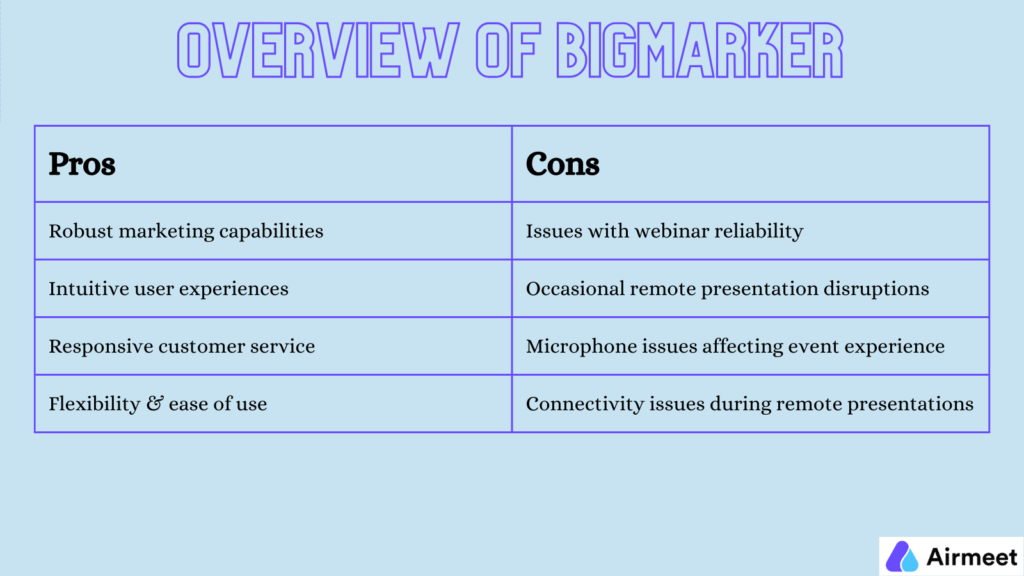
To see the full feature comparison chart and for a more detailed understanding of Airmeet vs. Bigmarker, click here.
16. Airmeet versus Demio
The basic design and emphasis on user-friendliness of Demio make it a good webinar platform for both the hosts and the attendees. Airmeet provides a more feature-rich environment for events that are dynamic and interesting. Airmeet is an option you should consider strongly if you are looking to host virtual events that are more dynamic and interactive.
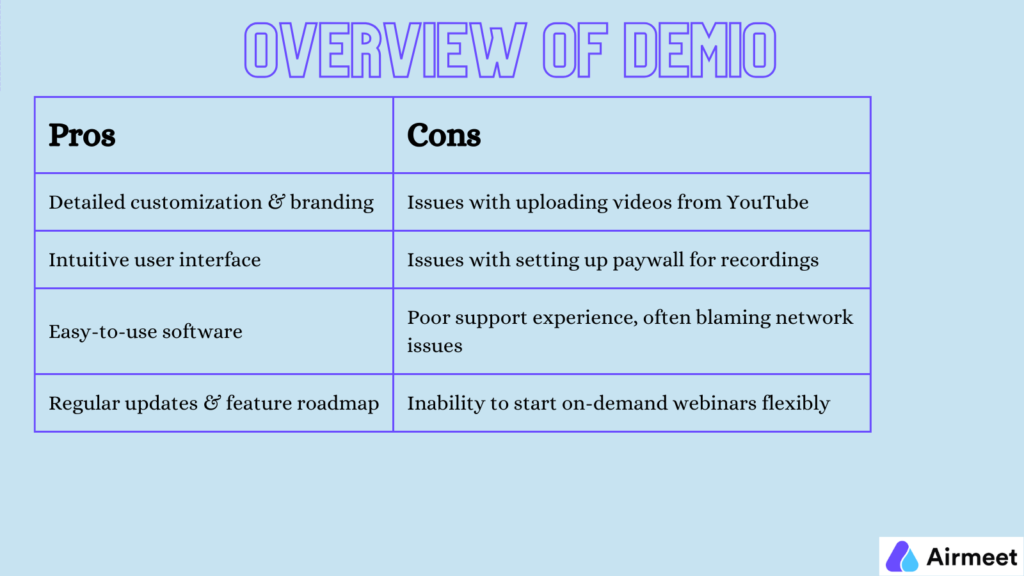
To see the full feature comparison chart and for a more detailed understanding of Airmeet vs. Demio, click here.
17. Airmeet versus GoToWebinar
One of the popular choices in webinar hosting, GoToWebinar has a proven track record of dependability and user-friendliness. On the other hand, Airmeet stands out by incorporating features such as event communities and interactive question and answer sessions that encourage attendees to participate in real time. Airmeet is also superior when it comes to its design that is scalable, tools that are engaging, and an interface that is easy to use.
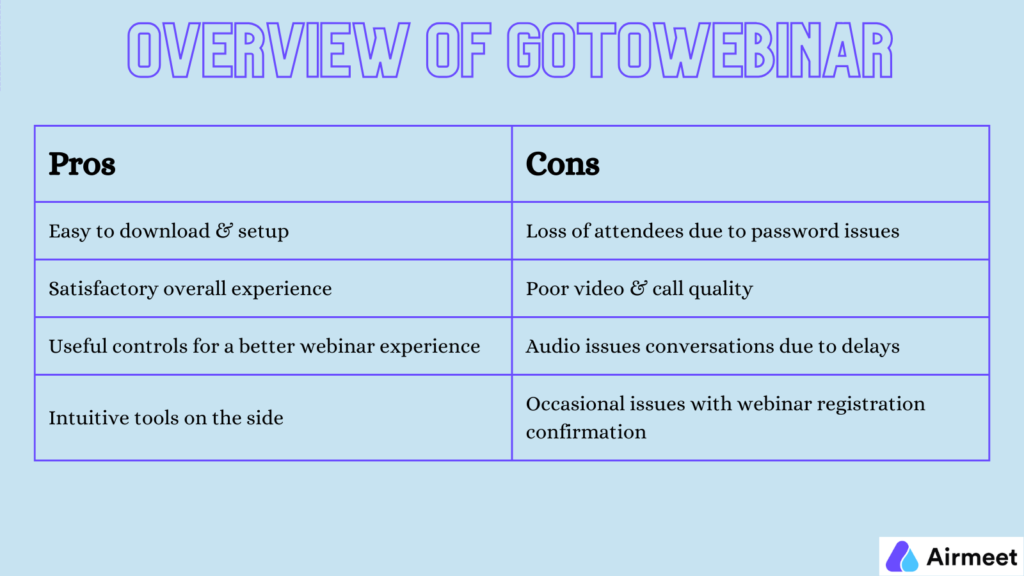
To see the full feature comparison chart and for a more detailed understanding of Airmeet vs. GoToWebinar, click here.
18. Airmeet versus Socio
Socio is a popular platform for hosting both online and offline events because of its versatility, customization options and networking features. Airmeet is a solid virtual event platform that focuses on close-ro-real virtual events experience and increased audience engagement. Airmeet is superior to Socio since it offers features such as question and answer sessions, virtual lounges, and interactive polls that allow attendees to form deeper connections with one another.
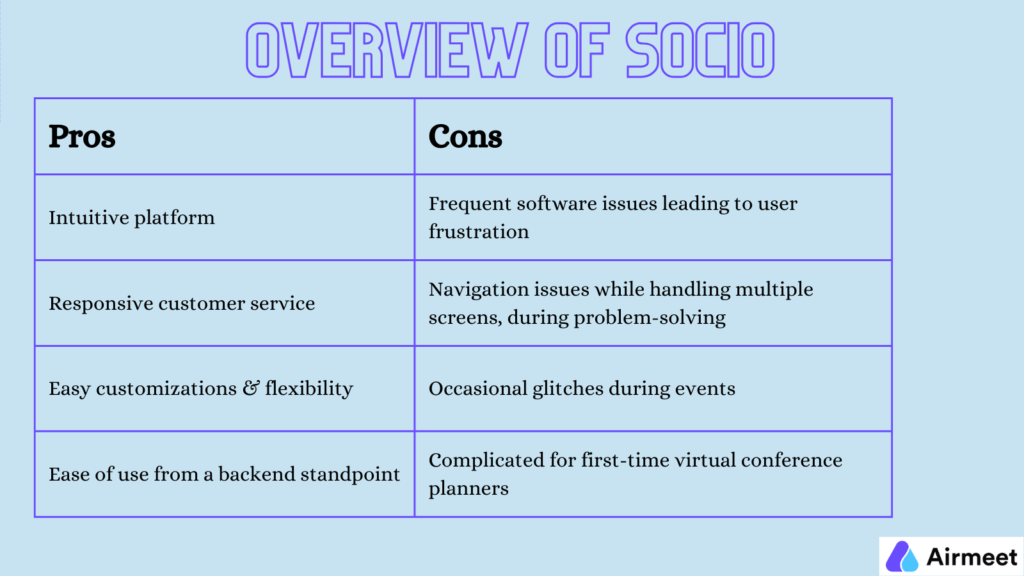
To see the full feature comparison chart and for a more detailed understanding of Airmeet vs. Socio, click here.
19. Airmeet versus Brazen
Brazen specializes in online hiring events and job fairs, with a particular emphasis on one-on-one talks. Airmeet, on the other hand, provides a wide variety of tools to enhance networking and engagement at a variety of events, such as conferences, webinars, job fairs and trade exhibits.
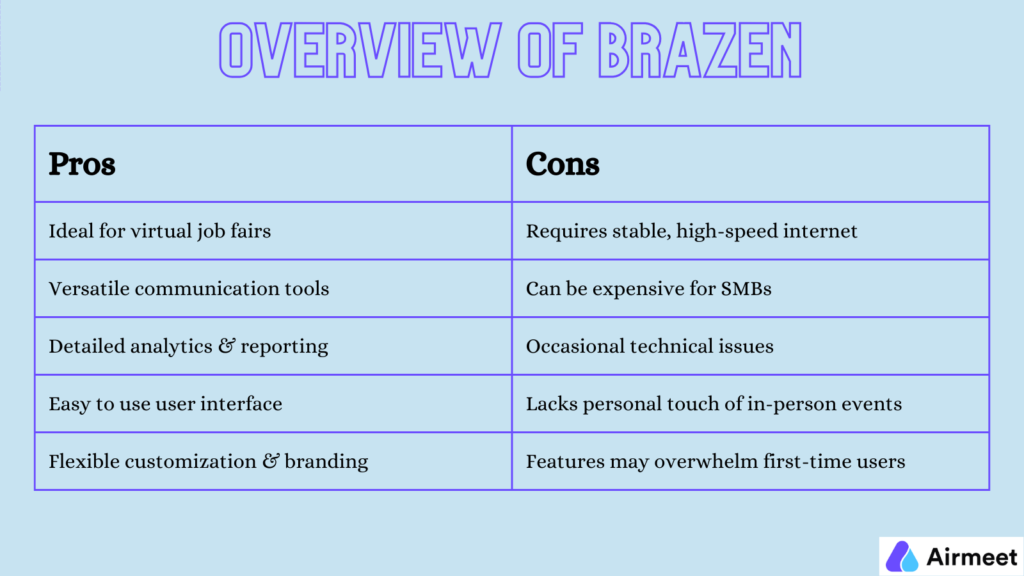
To see the full feature comparison chart and for a more detailed understanding of Airmeet vs. Brazen, click here.
20. Airmeet versus WebinarJam
WebinarJam is a popular choice for live webinars thanks to its user-friendly design and the marketing functionalities it offers. While webinarJam is a great tool for generating leads and conducting easy webinars, whereas Airmeet provides a more comprehensive solution for virtual events of all scales, with best-in-class integrations, analytics, data security, and networking features.
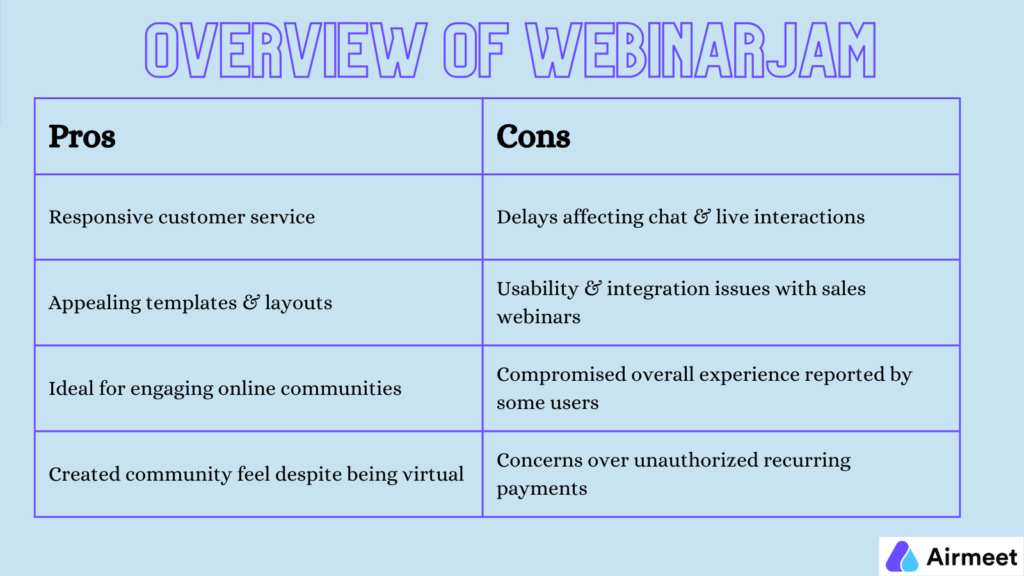
To see the full feature comparison chart and for a more detailed understanding of Airmeet vs. WebinarJam, click here.
21. Airmeet versus Goldcast
Goldcast is the ideal platform for business-to-business (B2B) marketing events offering premium event experiences, analytics, lead generation capabilities.Airmeet’s versatile platform, which works for a variety of events, attracts a larger audience than Goldcast’s marketing-focused features. Thanks to its robust features, scalability, dynamic networking capabilities and powerful analytics, Airmeet makes for a reliable virtual events platform.
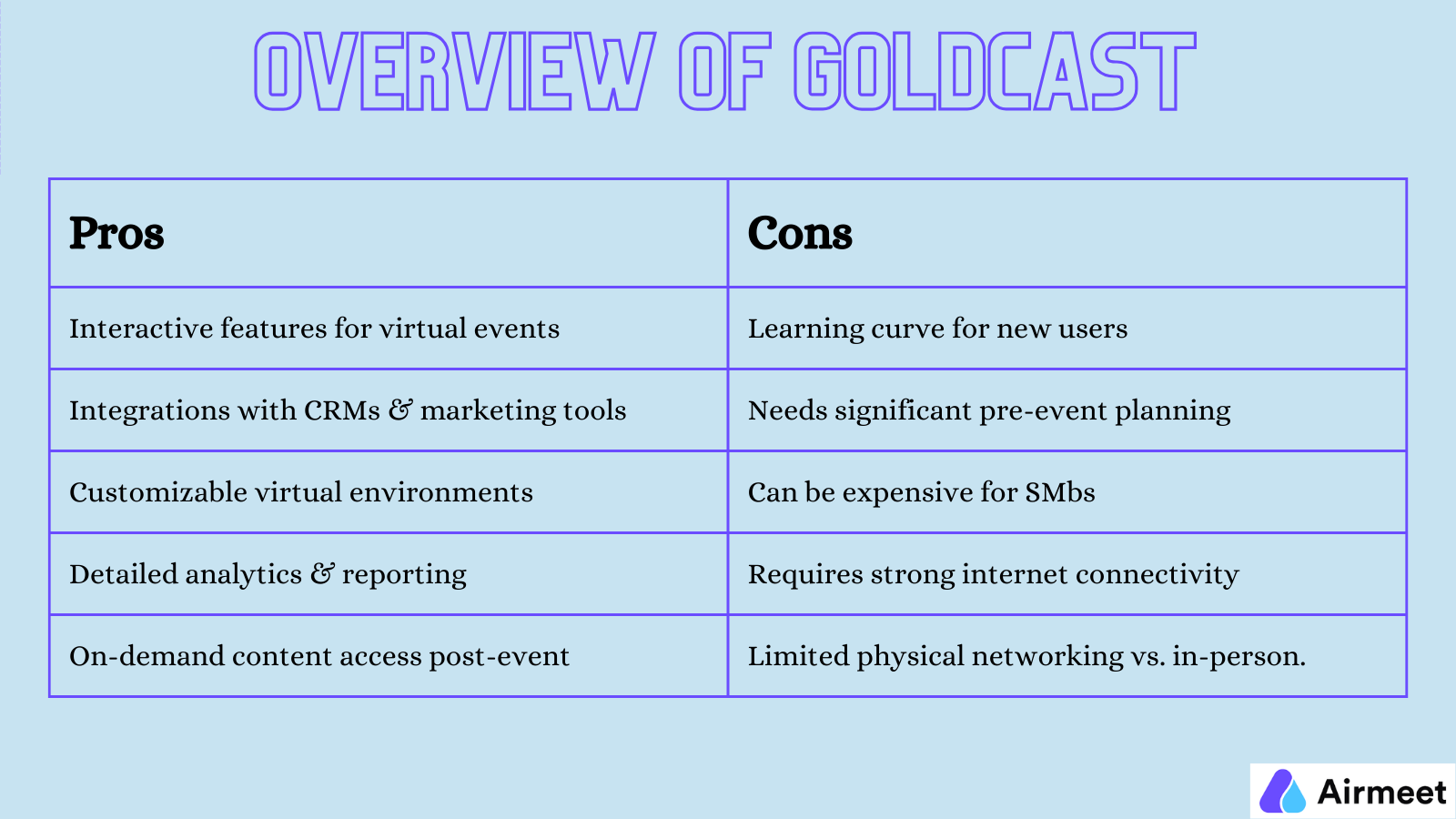
To see the full feature comparison chart and for a more detailed understanding of Airmeet vs. Goldcast, click here.
FAQ
You can host a wide range of online events using a virtual event platform—webinars, product launches, virtual conferences, trade shows, job fairs, networking events, workshops & more.
Virtual event platforms should offer branding and customization capabilities to tailor event landing pages, networking spaces, virtual booths, registration forms, email templates, and stage backdrops.
Platforms like Airmeet and Hopin (now RingCentral) offer free trial plans.
You can leverage tools and elements like
- Polls, live Q&A & chat messages
- 1:1 video meetings
- Speed networking
- Breakout rooms
- Networking lounges
There are several virtual event platforms that offer mobile app support—such as Airmeet, vFairs, and Zuddl.
Your event platform should support integrations for:
- CRM & marketing automation
- Collaboration & event engagement tools
- Polls & surveys
- Multilingual captioning tools
- Registration & payment gateways
For hosting virtual trade shows, you can explore well-equipped platforms such as Airmeet and vFairs.
These platforms offer diverse features to host trade shows—like custom virtual booths, dedicated networking lounges for exhibitor-visitor interaction, lead capturing, detailed analytics, and more.
Yes, many of the above-listed platforms support hybrid events, including Airmeet and RingCentral.































